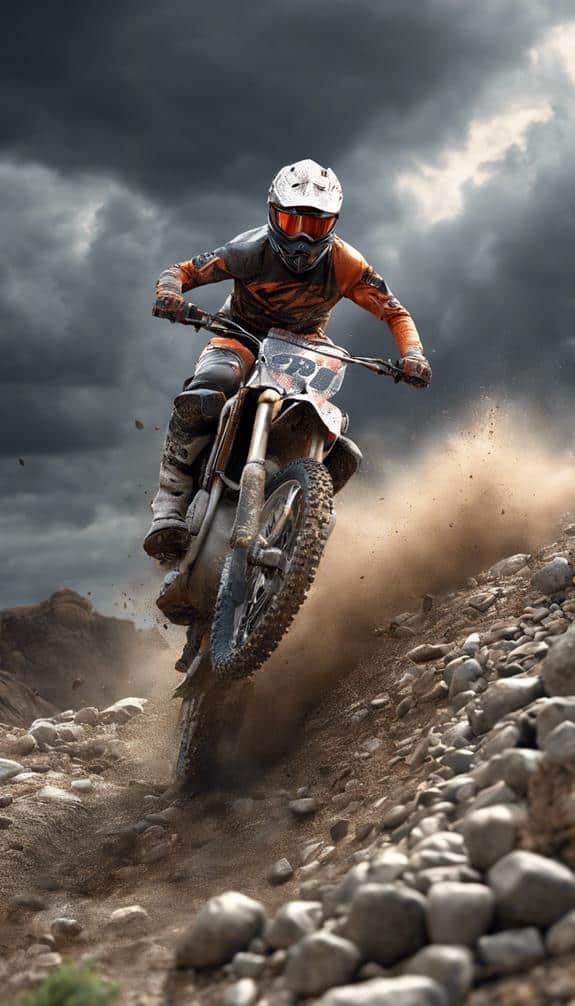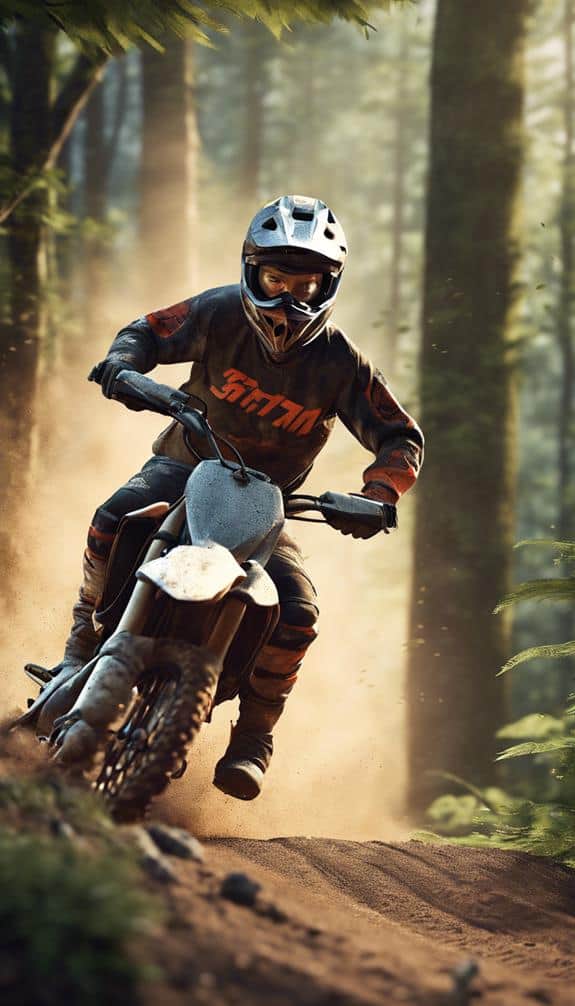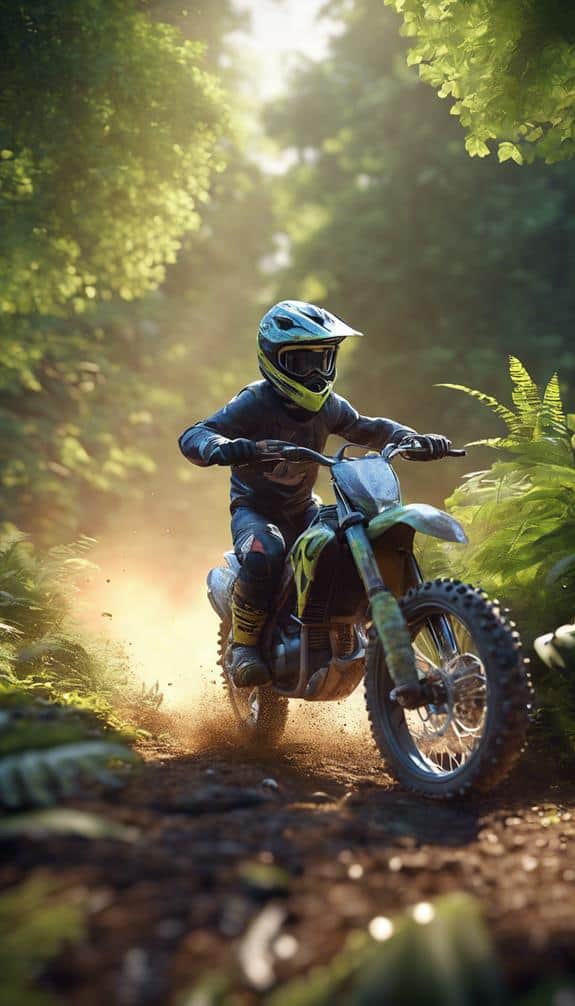To make dirt biking safer, it's critical you understand accident statistics. Over 12 years, there were 1,870 rider injuries, with nearly half of youth riders experiencing concussions. Wrists and ankles are most frequently fractured, accounting for 450 cases. Many accidents stem from terrain challenges and inexperienced riders. Maintaining equipment and mastering safety gear usage, like DOT-approved helmets, can prevent severe injuries. Training and maintaining physical fitness improve control and reduce risks. For young riders, education and supervision are essential for safety. These insights offer a foundation to improve safety strategies and reduce accident risks in dirt biking.
Key Takeaways
- Nearly 50% of youth riders sustain concussions, highlighting the need for effective head protection.
- Proper equipment maintenance is crucial to prevent mechanical failures and related accidents.
- Training courses improve riding skills, reducing accident rates and injury severity.
- High-quality safety gear, including helmets and body armor, significantly lowers injury risk.
- Terrain challenges and inexperienced riders are common causes of dirt bike accidents.
Analyzing Dirt Bike Injury Data
Analyzing dirt bike injury data provides essential insights into the risks associated with this popular sport. With 1,870 rider injuries recorded over 12 years, understanding these statistics is key to developing effective injury prevention strategies.
You should focus on rider education programs that emphasize safety measures and skill enhancement. Helmet effectiveness studies reveal that nearly 50% of youth riders suffer concussions, underscoring the importance of selecting proper headgear to mitigate risks.
Accident location analysis is important for identifying high-risk areas and tailoring your riding approach accordingly. Fractures, particularly to the extremities like wrists and ankles, account for 450 of the injuries and highlight the necessity of protective gear and proper training.
The average severity score of 8.5 illustrates the potential gravity of these injuries, prompting a need for robust recovery process insights that can guide you through rehabilitation and back onto the trail safely.
Though dirt bike accidents often don't necessitate intensive care compared to ATV incidents, the inherent risks aren't negligible. By integrating these data-driven insights into your practice, you can embrace the freedom of dirt biking while minimizing the likelihood of injury.
Common Causes of Dirt Bike Accidents

Understanding the common causes of dirt bike accidents is essential for enhancing rider safety and minimizing risks. Terrain challenges are a significant factor, destabilizing bikes and leading to loss of control, especially for those lacking rider experience. Safety training can mitigate these risks by teaching you how to handle unpredictable environments. Equipment maintenance is also vital; a well-maintained bike reduces the chances of mechanical failure during critical moments. Accident prevention starts with recognizing these factors and taking proactive steps to address them.
| Common Cause | Impact on Accidents |
|---|---|
| Terrain Challenges | Destabilizes bikes, leading to loss of control |
| Rider Experience | Inexperience increases accident likelihood |
| Equipment Maintenance | Poor upkeep can lead to mechanical failure |
| Safety Training | Reduces risk through better riding techniques |
With statistics revealing that 38% of dirt bike-related fractures involve multiple injuries, the severity of accidents can't be ignored. Even familiar trails pose risks due to the unpredictable nature of the environment. By focusing on accident prevention through targeted safety training, maintaining your equipment, and gaining experience, you can enjoy the freedom of dirt biking with reduced risk. Remember, the key to liberation on the trails is understanding and mitigating these common hazards.
Essential Safety Gear for Riders

When you're hitting the trails on a dirt bike, wearing the right safety gear is non-negotiable for minimizing injury risks. The helmet's importance can't be overstated—choosing a snug, undamaged, DOT-approved helmet less than 5 years old is essential. Head injuries are among the most common in dirt bike accidents, making helmet selection imperative for injury prevention.
Beyond helmets, protective equipment like knee and elbow pads, chest protectors, and body armor can greatly reduce injury severity during falls and crashes. This gear serves as a barrier against the rough and unpredictable terrain, allowing you to ride with confidence and a sense of liberation.
High-quality MX boots and ankle braces are recommended to fend off fractures and sprains, frequent injuries among riders. Eye protection, such as safety glasses, is crucial to prevent corneal injuries from debris and impacts.
Gear maintenance is key to ensuring its effectiveness. Regularly inspect your equipment for wear and tear, adhering to safety regulations.
Tips to Enhance Riding Skills

Improving your dirt bike riding skills requires a structured approach that combines education, practice, and self-awareness. By focusing on these elements, you'll navigate your path to becoming a more proficient rider. Here are key steps to enhance your skills:
- Enroll in Training Courses: These courses offer valuable insights into riding techniques and skill progression. They provide hands-on experience, allowing you to understand your limits and refine your control over the bike.
- Prioritize Bike Maintenance: Regular inspections and maintenance are crucial. Familiarize yourself with the owner's manual to guarantee your bike operates at peak performance, reducing the risk of accidents due to mechanical failures.
- Develop Terrain Awareness: Stay within your skill limits by avoiding unfamiliar terrains. This reduces the chances of losing control and prevents injuries. As your confidence and skills grow, gradually introduce more challenging environments.
Additionally, engaging in fitness training is essential. Physical conditioning, including stretching and warming up, enhances balance and control, contributing to safer riding.
Special Considerations for Young Riders

Many young riders face unique challenges and risks when it comes to dirt biking, necessitating special considerations to guarantee their safety. Youth education is essential, as nearly 50% of young dirt bike riders suffer from concussions. By emphasizing training courses, you can enhance skill development and risk awareness, important elements in preventing accidents.
Parental supervision plays a critical role, as parents can confirm that the proper safety gear is worn and that young riders operate within a safe riding environment. This oversight is fundamental, given the high incidence of orthopedic injuries, particularly fractures in extremities, among riders under 18.
Riding environment markedly impacts safety; selecting appropriate terrains can minimize the likelihood of accidents. Encouraging young riders to practice on familiar, less challenging tracks can help them build confidence and experience.
Community involvement also contributes to a safer riding culture. Participating in local riding groups can provide young enthusiasts with mentorship opportunities and peer support, fostering a shared commitment to safety.
Frequently Asked Questions
What Is the Main Cause of Dirt Bike Accidents?
It's no coincidence that rider experience plays a pivotal role in dirt bike accidents.
When maneuvering challenging terrain conditions, inexperienced riders often falter. Without proper safety gear, minor mishaps can become severe.
Investing in training programs boosts your skills, making you adept at accident prevention.
Analyze your riding habits: are you overconfident or undertrained?
Prioritizing experience and education liberates you from fear, letting you enjoy the thrill of the ride safely.
What Percentage of Dirt Bike Riders Get Injured?
You might wonder what percentage of dirt bike riders get injured. While exact statistics vary, understanding injury prevention through rider training and safety gear is vital.
Terrain awareness and accurate accident reporting also play important roles. Many injuries occur due to inadequate preparation, and focusing on these areas can greatly reduce risks.
Equip yourself with the right knowledge and gear, and you'll find freedom in riding safely and confidently.
What Is the Most Common Injury in Motocross?
The most common injury in motocross is to the extremities, especially fractures in the wrist and ankle.
You should focus on motocross safety by investing in protective gear like wrist guards and ankle braces.
Rider education is essential; understanding how to handle falls can aid injury prevention.
Implementing recovery strategies, including physical therapy, guarantees a smooth comeback.
Analyze injury trends to boost your skills and ride with confidence and liberation.
How Safe Is Dirt Biking?
Dirt biking can be exhilarating, but safety is crucial. Did you know riders with proper gear reduce injury risk considerably?
Protective gear, like helmets and pads, is essential. Mastering riding techniques on diverse terrain also enhances dirt bike safety.
Experience plays a role; skilled riders navigate challenges better. Analyze data and learn from it to ride safely.
Embrace freedom but always prioritize safety to enjoy every thrilling ride.
Conclusion
As you picture yourself traversing a rugged trail, remember that each choice—like wearing a snug helmet or mastering a precise turn—shapes your journey. Data reveals how these decisions can drastically cut accident risks. Imagine the peace as you confidently glide over obstacles, safeguarded by your understanding of the statistics. By committing to safety and skill development, you transform potential hazards into mere whispers of the wind, ensuring every ride is not only thrilling but secure.

